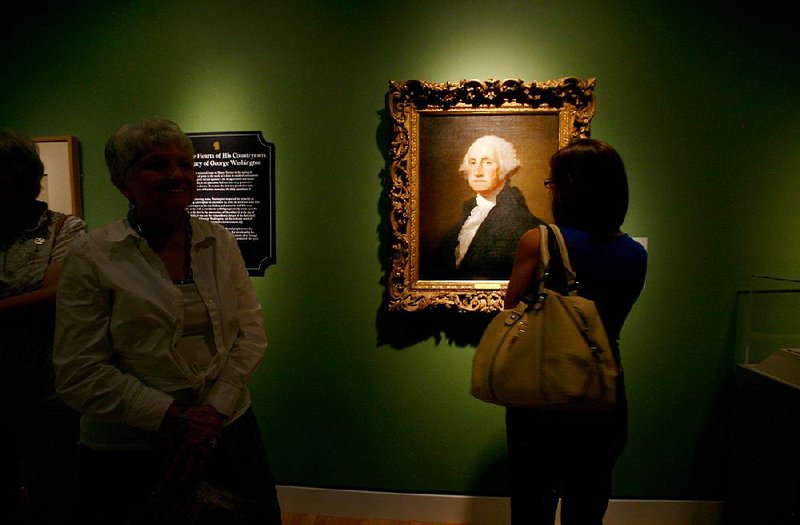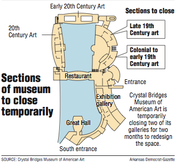Crystal Bridges Museum of American Art is closing its early-American art galleries for two months to redesign the space for the first time since opening to visitors in 2011.
The Colonial to Early 19th Century and Late 19th Century galleries will be inaccessible to guests from Jan. 9 to March 16 as Crystal Bridges "continues to rethink how American art is presented," according to Executive Director Rod Bigelow.
The temporary closure was among a handful of plans the museum revealed Tuesday, including new acquisitions and four sculptures that will be installed along the North Forest Trail.
Crystal Bridges curator Mindy Besaw said the gallery redesign has been a two-year project and is part of the museum's emphasis on diversity and inclusion, developing ways to appeal to a wider audience.
"Our hopes are to be more inclusive, a little broader in our way of thinking and helping people see the complexities of American art and history," Besaw said. "We feel like they can be part of that dialogue and use our galleries to start those conversations."
Over the past six years, Crystal Bridges' early American galleries have been home to familiar works like Asher B. Durand's Kindred Spirits and Gilbert Stuart's portrait of George Washington. Those paintings and other early American work will not be on display during the gallery redesign, but will be accessible for viewing online. Besaw said the majority of the pieces currently on display will return when the revamped space opens in March.
Crystal Bridges also plans to incorporate works on loan from other museums into the redesign to stand side by side with those permanent pieces. The museum has secured 18 to 20 loans, including Spanish Colonial and American Indian art to provide more "texture" to the work on display, Besaw said.
The museum also is working with the University of Arkansas to provide some pre-1400s American Indian objects.
The works on loan will offer a more diverse voice to what Besaw described as the "American spirit," helping visitors take a deeper look at topics such as Manifest Destiny and the American Indian removal of the 1830s.
The redesign was the product of numerous conversations with stakeholders, including volunteers, employees and museum officials, Besaw said. Museum staff members also organized community events.
"The things we really took away were that people were ready for complex reflections of the American spirit, whatever form that took," the curator said. "It wasn't all sunshine and roses and patriotism. It was also terms like greed, exceptionalism, inequity. Those kinds of terms were very much as present as freedom, individual, terms like that."
The theme is evident in two of the museum's latest acquisitions, which include Indian Land #4 (1980) by artist Fritz Scholder and The Cost of Removal (2017) by Titus Kaphar.
Scholder spent much of his career painting Indian themes and images that exposed the real-life issues and situations of American Indians. Indian Land #4 is from the artist's Indian Land series, which Crystal Bridges curator Lauren Haynes said is more abstract and darker than the artist's pop-art portrayal of American Indians from the 1970s.
Kaphar's work is based on Ralph Earl's 1833 painting Andrew Jackson on Sam Patch. In Kaphar's painting, Jackson's body from the nose down is covered by torn strips of canvas with Jackson's own writings weighing the costs of removing American Indians from their lands.
"I want to make paintings, I want to make sculptures that are honest, that wrestle with the struggles of our past, but speak to the diversity and the advances of our present," Kaphar said earlier this year during a TED Talk presentation. "We can't do that by taking an eraser and getting rid of stuff."
Kaphar's work is on view at Crystal Bridges in the 1940s to Now Gallery; Scholder's painting will be installed later this month.
"These pieces and everything that's happening with the reinstallation really is just continuing a lot of the initiatives and desires that have been set up at Crystal Bridges in the last few years," Haynes said. "It's really obvious there's not just one American story, and so what we've been trying to do, and continue to do, is to have more diverse voices telling different perspectives."
The museum also is installing four sculptures from its permanent collection on the North Forest Trail, which was home to the "Chihuly: In the Forest" outdoor exhibition until Nov. 27.
The trail will reopen Dec. 23 and include Tony Tasset's 12-foot tall Deer, which had been on loan to the city of Chicago. George Rickey's One Fixed Four Jointed Lines Biased, Carol Bove's Horse Lover and Fletcher Benton's Steel Watercolor No. 162 also will be on display in the museum's next plans for the outdoor space.
"The North Forest is a really fun space for us," Haynes said. "Everyone got to know it and enjoy it with 'Chihuly: In the Forest.' What this allows for us now is to bring permanent collection work out there and to be able to have people experience the forest in a whole new way."
Indoors, the redesigned galleries will primarily remain reserved for early American art. But Besaw said there will be a few contemporary pieces and other plans incorporated as well.
One example: The first segment of the redesigned space will serve as a brief introduction to the entire collection at Crystal Bridges. Besaw said the "orientation" will include works from the late 1700s to as recent as 2015, providing an overview before visitors move into the rest of the galleries.
The redesign also will include a rotating space for the museum to display works on paper. The mini-exhibition will change twice a year, with the first featuring figure drawings from the permanent collection.
The temporary closure changes how visitors access the permanent collection. Guests will be directed to step outdoors and walk across Walker Landing to reach the north side of the museum. Or they can move through the permanent galleries that are open to the public through the stairs and elevator next to Eleven Restaurant.
There will be a staged reopening of the galleries in early March. Besaw said the museum understands the temporary closure may be inconvenient for some, but reimagining the space is important for Crystal Bridges.
"It's one thing to be able to provide visitors with temporary exhibitions that are able to explore certain topics or artists in great depth, but this is our way of making sure our own collection galleries stay just as relevant and exciting as our temporary exhibitions," Besaw said.
"We're not doing anything horribly wrong in our early American galleries. But we can make it so much better and relevant, so why not do some experimentation to see what would happen if we looked at these things differently?"
Metro on 12/13/2017


